
What can arm amputees tell us about tomorrow’s packaging needs? According to a new study, this extreme user group provides a preview of the changing way humans interact with a wide variety of products and packaging, forcing packaging designs to adapt.
While multitasking isn’t a new activity--we eat while we drive, we open doors while holding a child’s hand, we make dinner and talk on the phone--the dramatic surge in smartphone usage is driving a permanent change in human behavior that designers and manufacturers simply can’t ignore.
A recent study investigated how arm amputees interacted with, and were challenged by, nearly 250 everyday products and their packaging across 18 different categories. Two-handed consumers were also surveyed to explore how they spent their days and how they fared with the same items.
The findings showed that two-handed consumers spent 40% of their day with one hand occupied. As a result, they attempt to interact with a variety of other products and packages using a single hand or finger.
Why amputees?
People are on the go and trying to get more done in less time. They desperately need items designed to accommodate that lifestyle. Yet precious little that we interact with on a daily basis has been designed to operate with only one hand. Basically, we are all living in a one-handed world, and who better to teach us than those who live elegantly and efficiently with one hand--arm amputees.
Most market research captures the consumer’s past. With this study, smart marketers and designers have the opportunity to not only understand where the consumer is headed in the future, but also get there first with new designs to meet their needs.
Technology not always the answer
While some may point to technology advances such as voice- or motion-activation as solutions to the challenge, low-tech items people use every day stand to benefit even more from design improvements. For the packaging industry, that means everything from juice pouches to cereal boxes to resealable sandwich bags.
Overall, one-quarter of amputee respondents found everyday items difficult to operate with one hand, with the degree of difficulty increasing with the complexity of the task. However, two-handed consumers also reported difficulty opening or using some products, even when both hands were fully available. In some cases, two-handed respondents reported more difficulty than the amputees.
Of the top 10 categories identified as difficult, nine of them were identical between one-handed and two-handed people. That means the issue isn’t with the consumer, it’s with the item they are trying to open or use.
Packaging among most difficult
Packaging types whose packaging provided the greatest challenge for both groups included condiment or yogurt cups with peel-off lids in the Other Food category; safety seals and pills in blister-packs in the Health/Medical category; and individually wrapped cheese sticks and crackers in a standard bag-in-box in the Snack category.
Packaging is ripe with opportunities for companies to differentiate themselves from their competitors by being easier to use with one hand. Convenience is the killer app. The study found that one-handed convenience creates delight and engenders loyalty in consumers. A product that is easy to use with a single available hand creates a tremendous competitive advantage for itself in the marketplace and can boost profits, since consumers will pay a premium for convenience.”
Finding solutions
In addition to providing data on individual packages within specific categories, the “One Handed World” syndicated study identifies 17 innovation platforms designers can use to innovate better and easier-to-open packages.
For example, the “One Handed Stabilization and Manipulation” platform identifies products that require one hand to do two different jobs: stabilize an item AND manipulate it at the same time, such as opening a jar. In the one-handed world, a product like that is a failure for the consumer.
Another platform is “Toothiness.” Despite the objections of dentists, many consumers use their teeth as a sort of “third hand” and, when employed safely, can be a beneficial tool.
It’s all about facilitating usage. People are changing, and companies that look to the future and change their designs can win big.
Kelley Styring is a Procter & Gamble and Frito-Lay market research veteran whose firm InsightFarm consults with Fortune 100 companies. More information is available for the onehandedworld.

























